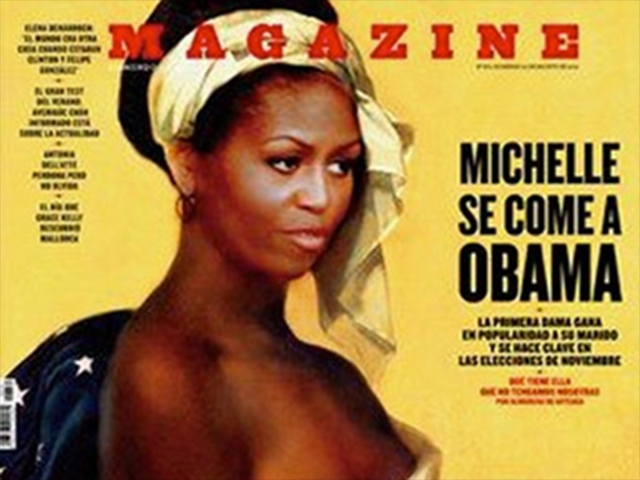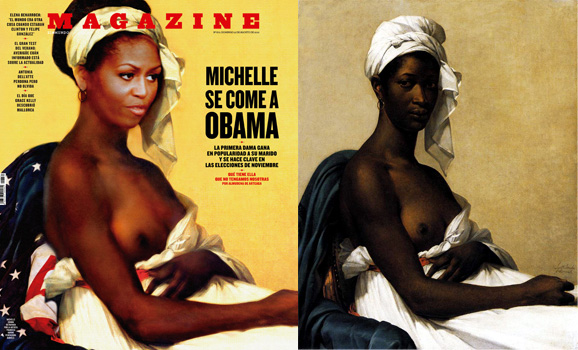
Image Credit: cropped version of Karine Percheron-Daniels magazine cover image
Even the First Lady can't escape the objectification of black women's bodies (at home and abroad).
The Internet has had a lot to say about the Spanish magazine cover unveiled last week depicting Michelle Obama bare-breasted, swathed in an American flag. Most reactions have been vehement condemnations, accusing the artist (Karine Percheron-Daniels) of racism at worst, and poor taste at best. The image involved certainly raises a lot of questions (about race, art, censorship, and objectification), and I'll get into more detail when you see the (theoretically) Not Safe For Work images after the jump.

The image is based on a painting by Marie-Guillemine Benoist titled Portrait d'une négresse, completed in 1800 and currently hanging in the Louvre. While the painting is a depiction of a slave, according to at least one art historian the portrait “may be seen as a voice of protest, however small, in the discourse over human bondage.”
Karine Percheron-Daniels, the artist responsible for the cover image, has responded to the various attacks and accusations of racism with a statement explaining her thought-process and expressing a (seemingly) sincere admiration for Mrs. Obama. And, to be fair, this image is one in a series of nude political figures including the likes of Abraham Lincoln, Princess Diana, Eva Peron, and Obama himself (among others).
It interests me that most coverage of the "story" has chosen to censor the image of Mrs. Obama while leaving the breast in the original portrait bare. This explicitly condemns Percheron-Daniels' work (as not-art) while retaining the artistic value of the original.
While much to do is being made of the artist’s choice of source painting, I’m particularly interested in the significance of the choices Percheron-Daniels made in her adaptation – particularly the shifting of the subject’s gaze.
In the original work, the woman depicted confronts the viewer directly – a much more active role than the demure, side-long glance of the Percheron-Daniels’ portrait. As such, the new image removes any agency from its subject, turning her body (and face) into an object to be gazed upon. This ties in with the Spanish magazine’s rather odd caption – that Michelle Obama’s face will be key in the upcoming election – as well as the continued American obsession with Mrs. Obama’s arms.
It also seems significant that Percheron-Daniels chose to incorporate the American flag, tying the image into nationalism. On the international stage, then, the cover portrays America as being inescapably tied to its roots in slavery, and the first lady is presented as an aesthetic object. And given the kind ofappalling headlines some coverage has indulged in, the incident is certainly disheartening – particularly if you heard NPR’s recent interview of GOP-leaning veterans in which Bobbie Lucier (of Indianapolis) complains that “It's about time we get a first lady in there that acts like a first lady and looks like a first lady.” And one can’t help but chalk that kind of comment up to race.
Hat tip to this year's viz. editor Rachel Schneider for helping me talk through these ideas.
Recent comments
2 years 29 weeks ago
2 years 44 weeks ago
2 years 44 weeks ago
2 years 50 weeks ago
3 years 4 weeks ago
3 years 4 weeks ago
3 years 4 weeks ago
3 years 6 weeks ago
3 years 6 weeks ago
3 years 6 weeks ago